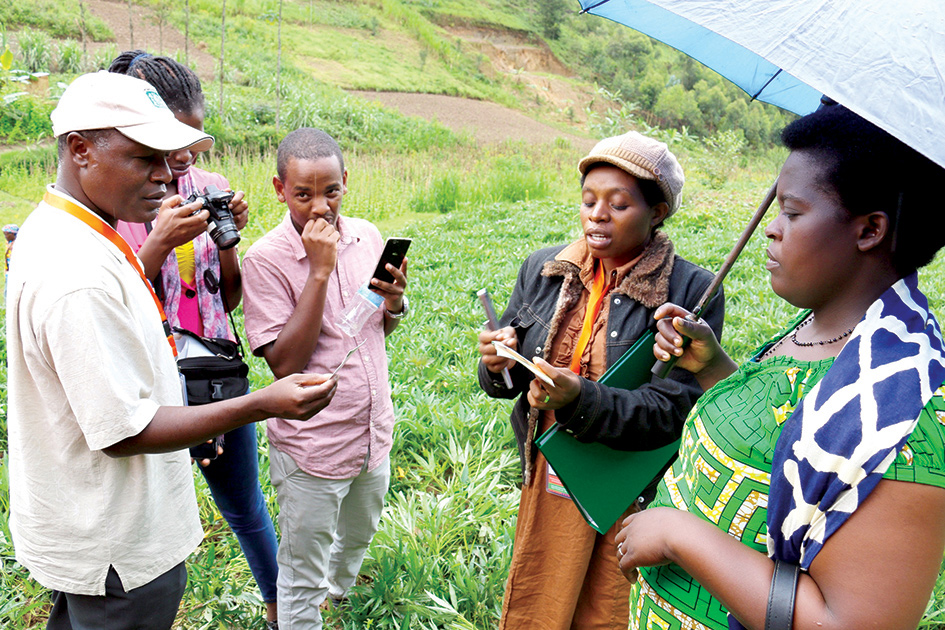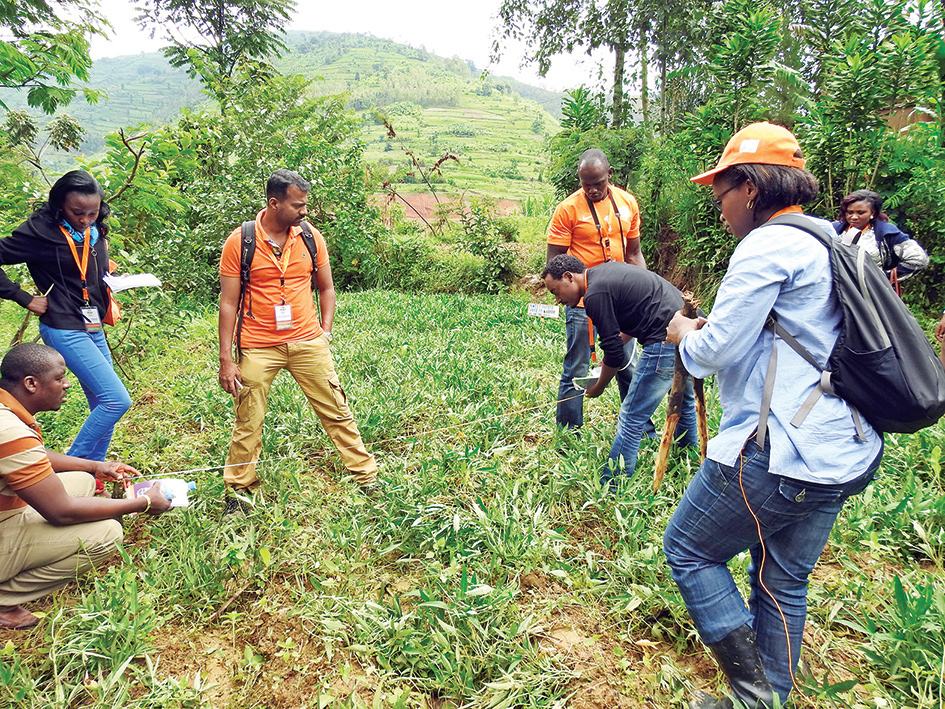Luka Wanjohi works at the International Potato Center (CIP), where he supports their Research Information Systems. Nafundi trained CIP staff on the use of ODK, and in this guest post, Luka describes how Nafundi's training and tools have helped with CIP's monitoring and evaluation efforts.
Monitoring data must be accurate and processed in a timely manner to be useful to project management. While different disciplines have already provided a significant amount of evidence regarding the effectiveness of using Information and Communication Technologies (ICTs) for data collection, most sweetpotato research work in Sub-Sahara Africa (SSA) continues to rely on pen-and-paper based data collection.
Consider the case of managing Decentralized Vine Multipliers (DVM) and vine dissemination. At the very least a project must collect DVM registration data, provide regular feedback from DVM field monitoring visits and vine beneficiary data. Often, data collection roles are shared among project field staff, partners and DVMs. It is not unusual that these data hardly get digitized in a timely manner. Gathering all the paper forms for digitization is a challenge in itself, especially for projects operating over wide geographical areas.
Besides the written responses, additional types of data collected from these DVM fields include photographs and geographic coordinates. Extra care must be taken to ensure that all these are correctly interlinked. People use mixed formats to record geographic coordinates. Dates become corrupted if the month and day fields are interchanged. Building robust quality assurance controls into data collection processes is challenging no matter what the collection format is.
Since 2014, the International Potato Center (CIP) through the Sweetpotato Action for Security and Health in Africa (SASHA) project has piloted the use of Android smartphones as a cost effective and accurate monitoring data collection tool. Significant effort has also gone into identifying suitable data visualization technologies that would allow researchers and managers get summarized views of field data. Electronic data collection should make it easier to have adoption of standardized data collection tools within and between projects. This in turn will enhance learning, promote research synergy, and contribute to tracking the progress toward achieving the Sweetpotato for Profit and Health Initiative (SPHI) goal, which is to improve the lives of 10 million African households in 17 SSA countries by 2020.
The first pilot was conducted in Nigeria in May 2014. Prototype forms based on ODK were used to register DVMs and record feedback from DVM backstopping visits by government extension workers. Since then, different ODK data collection modules have undergone iterative development and field testing in Burkina Faso, Ghana, Nigeria, Rwanda, Ethiopia, Uganda, Kenya, Malawi and Mozambique.
 Mukasine Jeanne, a DVM in Rwanda, responds to questions during the collection of DVM data. Photo courtesy of C. Bukania.
Mukasine Jeanne, a DVM in Rwanda, responds to questions during the collection of DVM data. Photo courtesy of C. Bukania.
For sweetpotato research in SSA, a smartphone is an exciting tool that could improve data collection. We are taking advantage of ODK, an open source suite of technologies that enables users to build data collection forms, collect data on Android mobile devices and send it to a server. The collected data are then aggregated and exported in different formats, as needed. The data collection forms can be authored using a spreadsheet application like MS Excel. To collect data, an active internet connection is not required. However, you must be connected to the internet to submit data to the server.
The SSA-based Monitoring, Learning and Evaluation (MLE) community of practice has been working together to develop and pilot agile ODK modules that can be adopted for routine monitoring activities by different projects. These modules will monitor DVM management; area, production and sales trends; production and sales by volume; nutrition; vine dissemination; yield estimation by crop cut and roots market price.
Project field staff and partners are being trained on data collection using ODK. These trainees have very diverse backgrounds, age and gender, with some having no prior experience with smartphones. Field training and remote support via phone calls and instant messaging platforms such as WhatsApp have seen the majority of these people successfully collect data over time.
We have been working mostly with CIP-led projects such as: Scaling Up Sweetpotato through Agriculture and Nutrition (SUSTAIN), Jumpstarting Orange-fleshed Sweetpotato (OFSP) and Feed the Future projects. We have also worked with HarvestPlus in Uganda.
 MLE community of practice members learn how to use crop cut method to estimate yield. Photo courtesy of J. Low.
MLE community of practice members learn how to use crop cut method to estimate yield. Photo courtesy of J. Low.
During the past year, we have captured new registration data of 326 DVMs (253 men and 73 women). DVM data has been integrated into the Sweetpotato Knowledge Portal, to enhance access to clean planting material produced by the DVMs. The system has also logged 250 DVM backstopping visits in Burkina Faso, Ghana, Nigeria and Kenya. In Rwanda, the yield estimation tool by crop cut was adopted and used to collect data in 99 households. In September 2016, a monitoring survey using adopted ODK modules on nutrition, trends and production modules will be used to monitor 2,000 households in Rwanda.
Nafundi has been instrumental in the course of running our pilot. Our first interaction with Nafundi was during a three day training on XLSForm development and XLSForm Offline in December 2014. We had started our ODK data collection pilot in Nigeria earlier the same year in May. Although only one person from CIP participated in this particular training event, it provided a window for us to interact and learn from other organizations who were already using ODK.
In 2015, our pilot began expanding to other countries in sub-saharan Africa and we realised that having in-country staff members who were competent in XLSForm development was going to be key for any successful deployment. Later that year, four colleagues from CIP participated in an ODK training organised by Nafundi and the Bill and Melinda Gates Foundation in Nairobi. Three of these were based in Nairobi and one in Ghana. Following this training, the quality of technical support for ODK based data collection improved significantly.
Although ODK tools have boosted standardization efforts in SSA, the level of adoption varies across countries, projects, age groups and gender. More capacity to develop and use ODK forms needs to be developed among researchers. Backstopping of ODK users will continue, so as to improve their proficiency. For more complex surveys, we are also developing CSPro for Android formats.
Costs associated with implementing and running the system are met by individual projects. Therefore, to increase their level of buy-in and support, we will channel significant efforts toward developing tools that provide rich insights to managers about the data being collected.
In early 2018, polio virus was detected in the sewers of Mogadishu, Somalia and the government moved quickly to vaccinate the country's children in order to prevent a potential outbreak. A vaccination campaign targeting more than 726,000 children was launched in the Banadir and Lower and Middle Shabelle regions. The campaign was carried out by some 3,500 staffers and Nafundi assisted by enabling real-time tracking of vaccination coverage using ODK. Read more.
Fayaz Jatoi is the Coordinator of the Emergency Operations Centre (EOC) for Polio Eradication in Sindh, Pakistan. In this guest post, Fayaz describes why AFP surveillance is critical to polio eradication and how an SMS-based reporting system for private care provider helps. Read more.
This position has been filled. Thanks to everyone who applied! Read more.